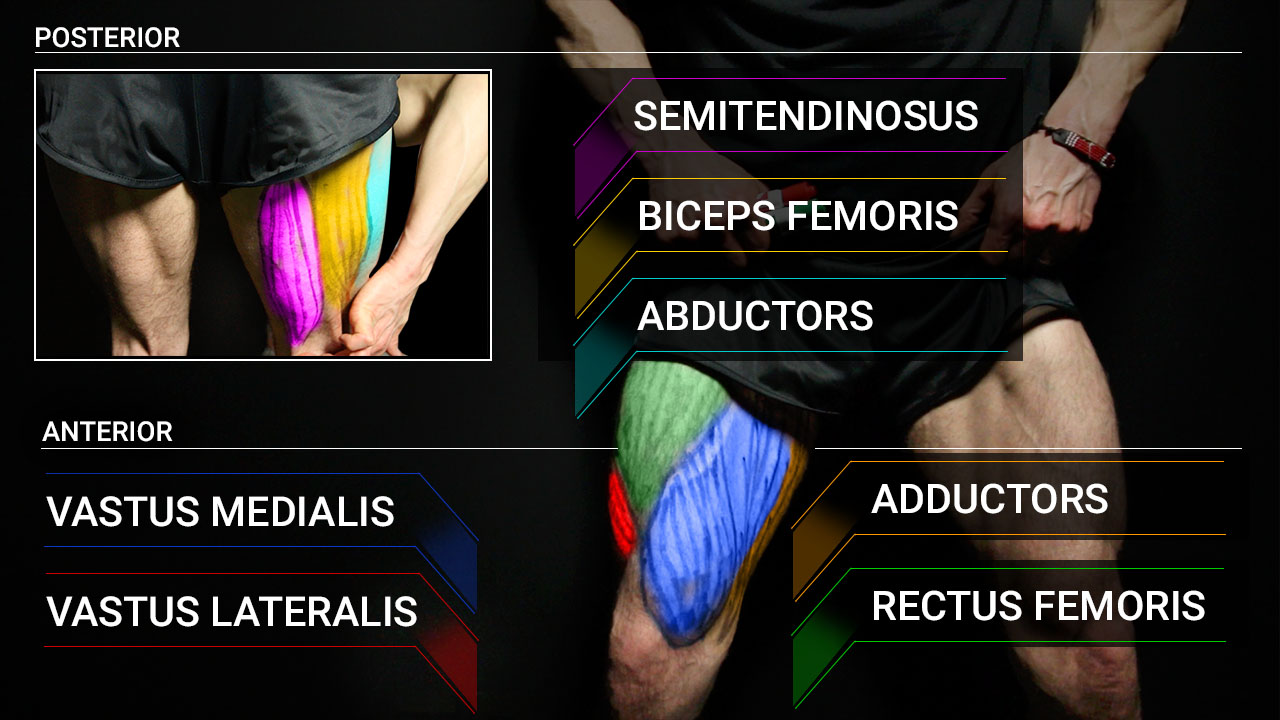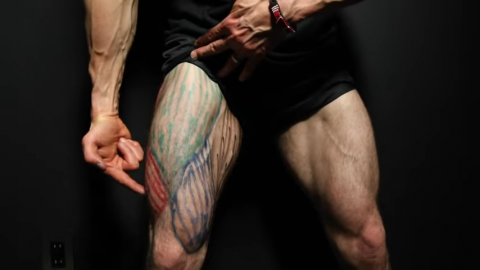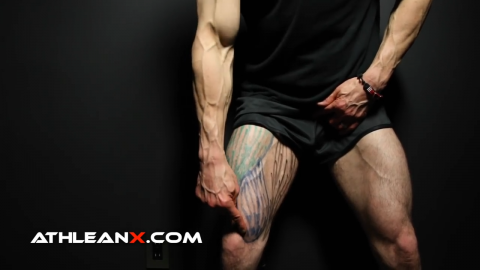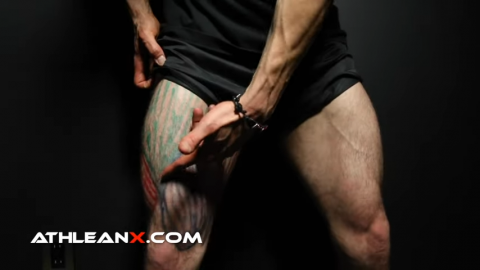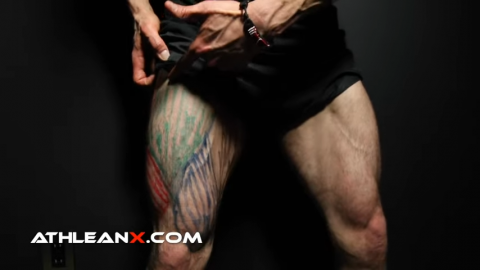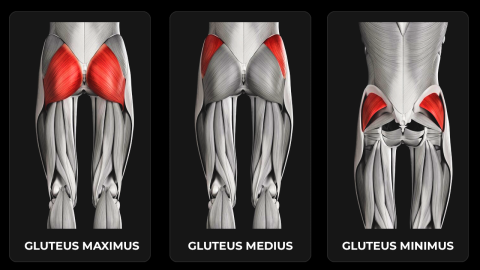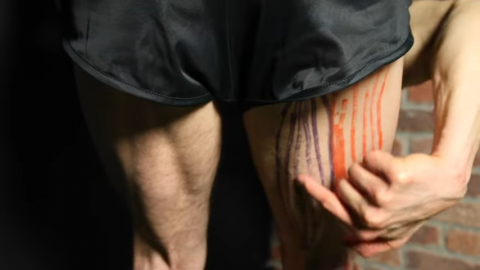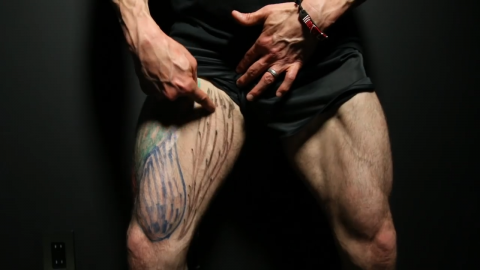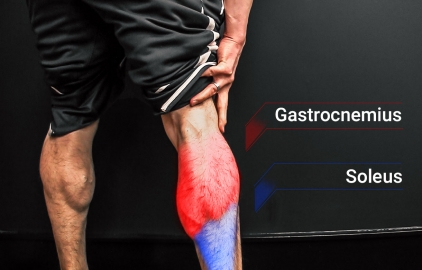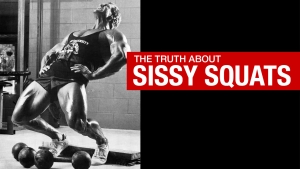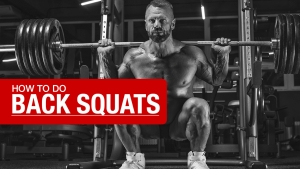
HOW TO MASTER DUMBBELL SQUATS
Think Dumbbell Squats are just a lightweight version of the Barbell Squat? Wrong!
If you’re relying solely on the traditional Squat for leg day, you’re probably leaving gains on the table.
Here’s the truth: your barbell obsession might be holding you back from true lower body development.
Most lifters stack plates on the bar but miss out on mastering proper squat mechanics, letting their lower back and shoulders take over while their legs do minimal work.
The Dumbbell Squat isn’t just an easier and safer alternative—it’s a wake-up call for those who’ve been neglecting full control and muscle engagement.
With dumbbells, there’s no hiding behind the bar; you’re forced to own every rep, stabilize your core muscles, and focus on moving the weight with the right muscles—your quads and glutes.
Think you’ve nailed your squat form? We’re about to find out.
It’s time to strip away bad habits and rebuild your squat from the ground up.
Let’s dive in and make sure you’re getting maximum results for your leg muscles without the injuries that come with poor technique.
DUMBBELL SQUATS: MUSCLES WORKED
It’s time to rethink your exercise program strategy when it comes to your lower-body muscle workouts. More specifically, you need to challenge the way you think about Squats.
Here’s the deal—while traditional Barbell Squats get all the hype, Dumbbell Squats could be the exercise your lower-body training is missing.
Most gym-goers mess up their squat form, letting poor knee alignment and bad foot placement limit their potential.
When done right, Dumbbell Squats target major muscle groups like your quads, glutes, and core with precision, making them one of the most versatile exercises for building strength, mobility, and real-world power.
Unlike Barbell Squats that lock you into a rigid movement pattern, Dumbbell Squats give you freedom of movement, allowing for better mobility and safer knee positioning.
Whether you’re working through regular Goblet Squats, Sumo Squats, or the classic Dumbbell Front Squat, these variations enhance muscle activation without sacrificing form or putting your lower back at risk.
The key to maximizing your Dumbbell Squat results is nailing the fundamentals—starting position, proper form, and consistent tension.
And the best way to master the squat form is to learn about the muscles you’re directly targeting.
Dumbbell Squats don’t target a single muscle – They activate multiple major muscle groups.
QUADRICEPS
Your quad muscles are the driving force behind effective Dumbbell Squats.
This muscle group, made up of four key heads, is responsible for powering your squat movements and building a serious base of strength.
Let’s break down how each head of the quadriceps muscles plays a role and why proper form is critical to maximizing your lower body workouts.
VASTUS LATERALIS
The vastus lateralis is the thick, outer portion of your quad.
This muscle is activated in squat exercises like Dumbbell Goblet Squats, Bulgarian Split Squats, and Sumo Squats.
It’s essential for knee stability and maintaining proper alignment, ensuring that your foot placement and squat position stay rock solid.
If you’re struggling with knee alignment or letting your knees cave inward, you’re not fully engaging this muscle, which can lead to improper form and an increased risk of injury.
VASTUS MEDIALIS
Located on the inner front thigh, the vastus medialis is crucial for knee extension and stability—especially in lower squat positions.
Whether you’re performing a deep squat or working on mobility with alternative squat variations, this muscle keeps your squat position locked in, allowing for better form and deeper range of motion.
Engaging the vastus medialis also helps distribute the load more evenly, reducing strain on your joints and improving overall squat mechanics.
VASTUS INTERMEDIUS
Hidden between the vastus lateralis and vastus medialis, the vastus intermedius runs down the center of your thigh and kicks into gear during exercises like the Dumbbell Squat Clean and Front Squats.
It plays a big role in maintaining an upright posture and stabilizing your knees during compound exercises.
Proper engagement here ensures you’re not cheating the movement and can handle heavier weights while keeping perfect form—especially when fatigue sets in during your entire workout.
RECTUS FEMORIS
The rectus femoris is the only quad muscle that crosses both the knee and hip, making it important for not just knee extension, but hip mobility flexion as well.
This muscle is activated in exercises like Overhead Squats and Dumbbell Front Squats, where maintaining a strong squat position requires both excellent mobility and power.
Engaging the rectus femoris helps you achieve full squat depth, whether you’re working with a single dumbbell, a pair, or performing more complex squat variations.
GLUTES
Your glute muscles are the powerhouse behind hip extension, stability, and overall lower-body strength development in regular Squats with dumbbells.
If you’re skipping glute engagement, you’re missing out on the development in strength, balance, and explosiveness that drive effective squat workouts.
GLUTEUS MAXIMUS
The gluteus maximus is the largest and most powerful of the glute muscles.
Located at the top of your buttocks, it’s the key player in hip extension—critical for standing up out of the squat position.
This muscle takes on the load to give you the power and stability you need for proper form.
Poor activation of the gluteus maximus is a common mistake that leads to overreliance on your quads and lower back, risking injury and compromising your gains.
To maximize the benefits of your Dumbbell Squats, focus on squeezing your glutes as you drive up from the squat position.
This ensures that your hip extension is fully powered by the gluteus maximus, leading to better form and more effective muscle development.
GLUTEUS MEDIUS
The gluteus medius sits on the outer upper buttock and plays a key role in maintaining balance and stability during squat variations.
Whether you’re performing Dumbbell Side Squats, Single Leg Squats, or basic Dumbbell Squats, the gluteus medius helps keep your knees aligned and your pelvis stable.
It’s also responsible for hip abduction—moving your thigh away from your body’s midline—which is crucial for exercises that challenge your balance purposes, like Bulgarian Split Squats and Single-Leg Exercises.
Ignoring this muscle is a recipe for poor squat form, leading to knee instability and a lack of control, especially during the descent.
Engage the gluteus medius to maintain proper foot placement and knee alignment, reducing your risk of injury and enhancing your overall squat performance.
GLUTEUS MINIMUS
Don’t let the size of muscles fool you here—though it’s the smallest of the glute muscles, the gluteus minimus is vital for executing dumbbell squats with proper mechanics.
Positioned beneath the gluteus medius, it helps stabilize your pelvis and keeps your hips level throughout the squat movement pattern.
This muscle also assists with inward rotation of the thigh, which is critical during Deep Squats and variations that require greater mobility.
Activating the gluteus minimus during Dumbbell Squats improves balance and control, allowing for smoother movement and better squat depth.
Proper engagement of this muscle ensures that your hips remain stable from the starting position to the full squat, making every rep more effective.
HAMSTRINGS
Flip around to the back of your legs and you’ll find the hamstring muscles—the heroes of lower-body strength level and stability.
These muscles do more than just help you stand up; they’re essential for maintaining balance, controlling your squat movement, and driving explosive power.
Here’s why you can’t overlook them in your Dumbbell Squat workouts.
BICEPS FEMORIS
The biceps femoris, one of the main muscles of your hamstrings, plays a crucial role in both knee flexion and hip extension.
While it’s often associated with exercises like Deadlifts and sprints, this muscle is equally important in Dumbbell Squats.
Why?
It enhances your ability to control squat depth and maintain proper form, especially when you’re working with heavier weights.
During Standard Dumbbell Squats or variations like the Dumbbell Goblet Squat and Dumbbell Sumo Squat, the biceps femoris stabilizes the knee joint and supports posterior chain muscles, allowing you to maintain balance and avoid common mistakes like shifting weight to your toes or letting your knees cave in.
If you want real power and stability in your popular lower-body movements, don’t sleep on the importance of stronger muscles with your hamstrings.
SEMITENDINOSUS
The semitendinosus works hand-in-hand with the biceps femoris, handling knee flexion, hip extension, and stabilizing your pelvis throughout the squat movement.
This muscle becomes especially important as you sink into the squat and drive up from the bottom position. Whether you’re doing Dumbbell Side Squats, Plie Squats, or even a challenging Single-Leg Squat, the semitendinosus helps keep your form in check and your movement controlled.
One of the biggest squat mistakes people make is not properly engaging their hamstrings during the exercise.
This leads to imbalances, poor mobility, and increased risk of injury.
By activating the semitendinosus, you improve your hip stability, control your squat depth, and enhance your ability to handle heavier loads with proper form.
ADDUCTORS AND ABDUCTORS
When most people think about squats, they focus on the quads and glutes, but if you’re skipping the adductors and abductors, you’re leaving strength—and stability—on the table.
These muscle groups play a critical role in stabilizing your squat movement and maintaining proper form, especially when using a pair of dumbbells. Let’s break it down.
ADDUCTORS
Your adductors, located on the inner thigh, are responsible for bringing your legs toward the midline of your body (hip adduction).
In Dumbbell Squats, they work behind the scenes to stabilize your knees and help you achieve and maintain proper squat depth.
When you’re performing alternative squat variations like the Dumbbell Goblet Squat or Dumbbell Sumo Squat, strong adductors keep your knees from caving in—a common mistake that puts you at risk for injury.
Want to boost your lower-body strength and mobility? Don’t ignore the adductors.
Strengthening these muscles not only enhances your squat mechanics but also improves your overall athletic performance.
Include exercises like Lateral Lunges and Bodyweight Squats with a wider stance to target this often-overlooked muscle group.
ABDUCTORS
Now, let’s talk about the abductors—the muscles on the outer thigh that drive leg stability and control lateral movement.
During squats, especially in wide stance positions like the Dumbbell Sumo Squat, the abductors help keep your knees properly aligned and ensure your squat form stays solid.
Weak abductors can lead to imbalances, poor movement mechanics, and an increased risk of injury.
Strengthening exercises help your abductors in maintaining balance during single-leg exercises like Bulgarian Split Squats and Single-Leg Dumbbell Squats.
Incorporate moves like Banded Side Steps and Lateral Leg Raises to build strength with dumbbells in your abductors and support better squat control, no matter what variation you’re tackling.
CALVES
When people think about squats, they rarely consider how their calves are involved.
But if you’re ignoring these two key muscles—the gastrocnemius and the soleus—you’re missing out on stability, power, and even better squat form.
Let’s break down why your calves are more than just show muscles when it comes to dumbbell squats.
GASTROCNEMIUS
The gastrocnemius is the muscle everyone wants to show off. It’s that thick, diamond-shaped muscle that gives your calves their size.
In Dumbbell Squats, this muscle plays a vital role in knee flexion and foot plantar flexion—critical for pushing through the standing position of your squat.
Whether you’re grinding through a set of heavy Dumbbell Goblet Squats or challenging yourself with Dumbbell Sumo Squats, the gastrocnemius helps drive you upward from the bottom position.
But here’s the deal: just training this muscle alone isn’t going to give you fully developed calves—or better squat performance. That’s where the soleus comes in.
SOLEUS
The soleus is the muscle hidden beneath the gastrocnemius, and while it doesn’t get the spotlight, it’s doing a ton of work behind the scenes.
It’s your go-to muscle for ankle strength, stability, and control during the squat movement pattern.
The soleus kicks in during deeper squat positions, especially when you’re holding heavier weights, helping you maintain proper form and balance from the floor to shoulders.
Building muscle in your soleus doesn’t just support squat mechanics—it pushes the gastrocnemius out, making your calves look bigger and more defined.
This muscle plays a key role in stability during exercises like Leg Box Squats and Single-Leg Squats, ensuring your foot placement and stance remain locked in.
Without a strong soleus, you’re setting yourself up for poor movement mechanics and potentially risking injury during complex squat variations.
ABDOMINALS
When you think about squats, you’re probably picturing leg strength and mobility.
But if your core isn’t locked in, your squat form—and gains—are going to suffer.
Your abdominal muscles, particularly the rectus abdominis, play an important role in stabilizing your torso during Dumbbell Squats and protecting your spine from injury.
RECTUS ABDOMINIS
The rectus abdominis isn’t just for show; this six-pack muscle is your front-line defense against folding under the load.
Running vertically from your rib cage to your pelvis, it’s responsible for maintaining a stable trunk during the squat movement.
Holding a pair of dumbbells boosts the work for the core!
With the dumbbells at shoulder level, this muscle works overtime to keep you upright and prevent the common mistake of rounding your lower back.
In Dumbbell Squat variations with different position options like the Goblet Squat, Dumbbell Front Squat, and even Squat hold variations, your rectus abdominis engages isometrically to counterbalance the load and keep your spine aligned.
The stronger this muscle is, the more stable your stance positions become—whether you’re using a standard shoulder-width stance or switching things up with a narrow or wide stance.
When you take that deep inhale and brace before lowering into your squat, your rectus abdominis fires up to provide the tension needed for controlled movement.
It’s not just about excellent strength; it’s about maintaining the right lines of strength from floor to shoulder blades.
Proper engagement ensures that your squat form remains solid from start to finish, minimizing the risk of injury and maximizing depth and range of motion.
HOW TO DO DUMBBELL SQUATS
You now know which muscles you’re targeting, so let’s break down how to master one of the most effective full-body exercises: the Dumbbell Squat.
This isn’t just about picking up a pair of dumbbells and going through the motions—it’s about perfecting your form, avoiding common mistakes, and building real-world strength.
Let’s breakdown the anatomy of Squats with dumbbells.
DUMBBELL SQUATS


HOW TO DO THE DUMBBELL SQUAT:
- Grab a pair of dumbbells and hold them at your sides or in a racked position at shoulder height, depending on your preferred variation.
- From the rack position, start with your feet shoulder-width apart and toes slightly pointed out for optimal stability.
- Get into a position with heels planted. Keep your entire foot flat on the ground, from heel to toe. No raising your heels or rolling onto the balls of your feet.
- Engage your core and keep your chest up. In other words, perform the “Superman posture”—chest up, shoulders back. This keeps your upper body stable and prevents rounding of the spine.
- Push your hips back first, then bend at the knees to lower into the squat. Your knees should track over your toes, not collapse inward. This is where many lifters go wrong.
- Lower your body until your thighs are parallel to the floor or deeper if your mobility allows. Make sure your knees stay aligned, not caving in or bowing out.
- Push through your heels and midfoot as you return to the starting position. Think about engaging your glutes and quads for explosive power as you rise.
- Keep your core tight throughout this powerful movement. The rectus abdominis is working overtime to maintain muscular balance and protect your lower back.
WHAT MAKES IT EFFECTIVE: The Dumbbell Squat is more than just an accessory exercise—it’s an effective exercise staple for building full-body strength, muscle hypertrophy, and mobility. Dumbbell Squats offer an excellent range of motion, allowing you to adjust your stance, load, and depth based on your needs and limitations. This makes them a great beginner exercise and a powerful challenge for advanced lifters.
DUMBBELL SQUAT VARIATIONS
While the Dumbbell Squat is a great foundation, sticking to one variation is like trying to build a house with just one tool.
To really target every muscle, improve mobility, and level up your strength, you need to mix things up with different squat variations and dumbbell holding positions.
From Sumo Squats to Goblet Squats, these alternative Dumbbell Squats are the gateway exercises to not only challenge your body in new ways but also correct imbalances and optimize your gains.
Let’s dive into the muscle builders that will take your leg training from basic to beast mode.
BODYWEIGHT SQUAT / AIR SQUAT

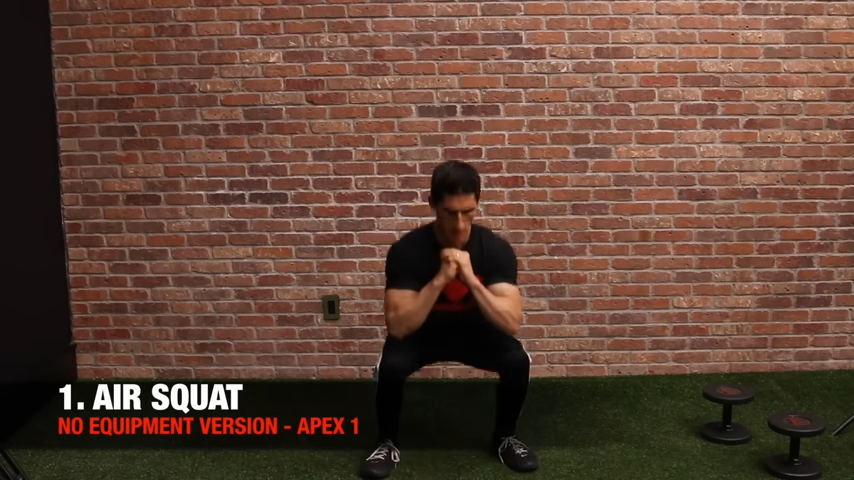
HOW TO DO THE BODYWEIGHT SQUAT/AIR SQUAT:
- Stand with your feet shoulder-width apart, toes slightly turned out. This stance gives you the best base for stability and depth. Imagine gripping the floor with your feet to create a strong connection—this sets the stage for everything that comes next.
- Don’t skip this step! Before you even move, brace your core like you’re preparing to take a hit. A strong core keeps your torso stable and prevents your lower back from rounding—a common mistake that can lead to injury. This is why core exercises are key in any program.
- Initiate the movement by pushing your hips back, as if you’re sitting into a chair. Let your knees bend naturally while keeping your chest up. Aim to get your thighs parallel to the floor or lower, depending on your mobility. If you find that your knees cave inward or you struggle with depth, focus on mobility drills to improve this over time.
- As you lower, keep an eye on your knee alignment. Your knees should track over your toes, not cave in toward each other. A quick test? During the squat, see if your left knee touches an imaginary line toward your toe. If not, you might need to work on hip stability and mobility.
- Drive through your heels and midfoot to stand back up, extending your hips at the top. Don’t let your chest drop forward—keep your core tight and finish the rep in a strong, upright position.
- Don’t forget about time for recovery! Between sets, focus on quality over quantity. Bodyweight squats might seem easy, but the goal is to master perfect form, maintain muscle tension, and improve joint mobility. It’s all about building a foundation for bigger lifts and more movement complexity.
WHAT MAKES IT EFFECTIVE: You might think a bodyweight squat is basic – a move you can do your entire life, but if you’re not doing it right, you’re missing out on one of the most foundational movements for strength, mobility, and overall health. The bodyweight squat isn’t just for beginners; it’s a go-to move for building functional strength for a healthier life and checking in on your movement quality.
GOBLET SQUAT


HOW TO DO GOBLET SQUATS:
- Grab a dumbbell and hold it vertically, cupping one end with both hands. Keep the dumbbell close to your chest, elbows tucked in, and maintain a strong, upright posture.
- Your feet should be shoulder-width apart with toes slightly pointed out—this stance gives you a solid base and improves your squat depth.
- This movement isn’t just about your legs—it’s a full-body exercise that demands core stability. Before you even think about squatting, brace your core as if you’re preparing for a punch. Insufficient core strength is one of the biggest reasons people struggle with proper squat form.
- Begin the squat by pushing your hips back, then bending your knees. Your goal is to keep your chest up and shoulders back as you lower your body.
- Imagine sitting back into a chair while keeping the dumbbell steady at your chest. You want to reach a depth where your thighs are at least parallel to the ground—or deeper if your mobility allows it.
- As you squat, make sure your knees are tracking in line with your toes. A common mistake is allowing the knees to cave inward—this is where the note of form differences becomes crucial. If you find your knees collapsing, it’s a sign that either your mobility needs improvement or you’re lacking core strength.
- Drive through your heels to stand back up, fully extending your hips at the top. Keep your core tight and avoid letting the dumbbell pull you forward. The challenge here is maintaining perfect form and not rushing through the movement.
- The Goblet Squat is an excellent exercise for improving hip and ankle mobility, which are often weak links in traditional squats. If mobility is a limitation, consider incorporating an 11-move mobility routine into your program to enhance your squat mechanics.
WHAT MAKES IT EFFECTIVE: The Dumbbell Goblet Squat might be a great exercise for beginners, but don’t let that fool you—this movement is great for building lower-body strength, mobility improvement, and targeting a lack of core strength. Whether you’re new to squats or a seasoned lifter looking for a joint-friendly alternative to heavy barbell lifts, this exercise should be a staple in your routine.
DUMBBELL JUMP SQUAT

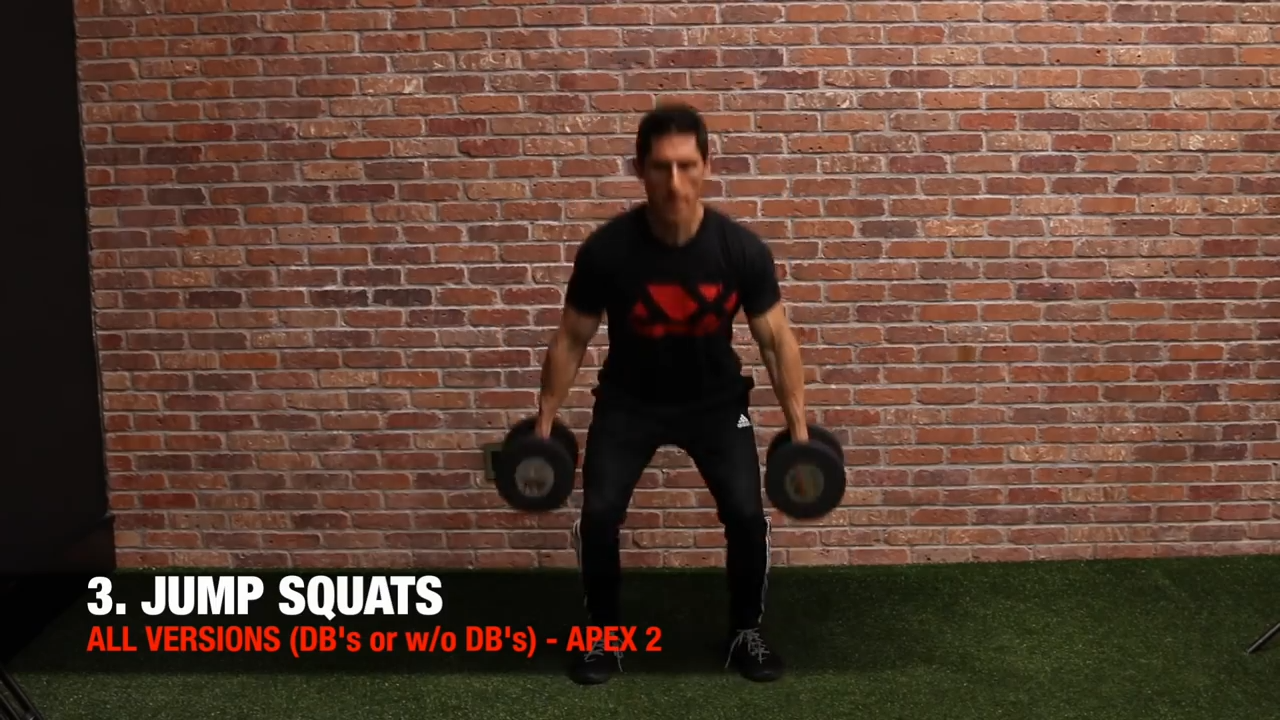
HOW TO DO DUMBBELL JUMP SQUATS:
- Start by holding a dumbbell in each hand, arms hanging naturally at your sides. Choose lighter weights—around 25% to 50% of your body weight—to maintain speed and power. For example, if you weigh 200 pounds, aim for 25-pound dumbbells in each hand.
- Stand with your feet shoulder-width apart, ensuring your entire foot is planted firmly on the ground. Your stance should feel stable and ready to generate power.
- Begin by lowering into a squat, focusing on proper movement mechanics. As you descend, engage your core muscles, keeping your chest up and spine neutral. This eccentric loading phase is key for setting up the explosive jump.
- Explode upward by extending through your ankles, knees, and hips in sequence. This movement pattern is crucial for transferring power from the ground up through your entire body.
- After the jump, land softly back into the squat position, absorbing the impact with your quads. Avoid heavy, jarring landings that could compromise your form or lead to injury.
- Take a moment to reset before each rep. Focus on quality over quantity—perform each jump with maximum power and precision, not to failure. The goal is to accumulate high-quality, powerful reps in set times, maximizing your speed output and overall strength.
- If you’re new to this exercise, consider doing a squat without weights to get the form down before adding any dual load. The bodyweight exercise version of this is just as effective.
WHAT MAKES IT EFFECTIVE: The Dumbbell Jump Squat is a brilliant exercise – very similar to the Barbell Squat Clean – for targeting secondary muscles and developing explosive strength through triple extension—ankles, knees, and hips. Whether you’re looking to improve your performance in Olympic weightlifting exercises like the Power Clean or simply add an explosive edge to your lower-body workouts, this movement delivers.
DUMBBELL SQUAT CLEAN

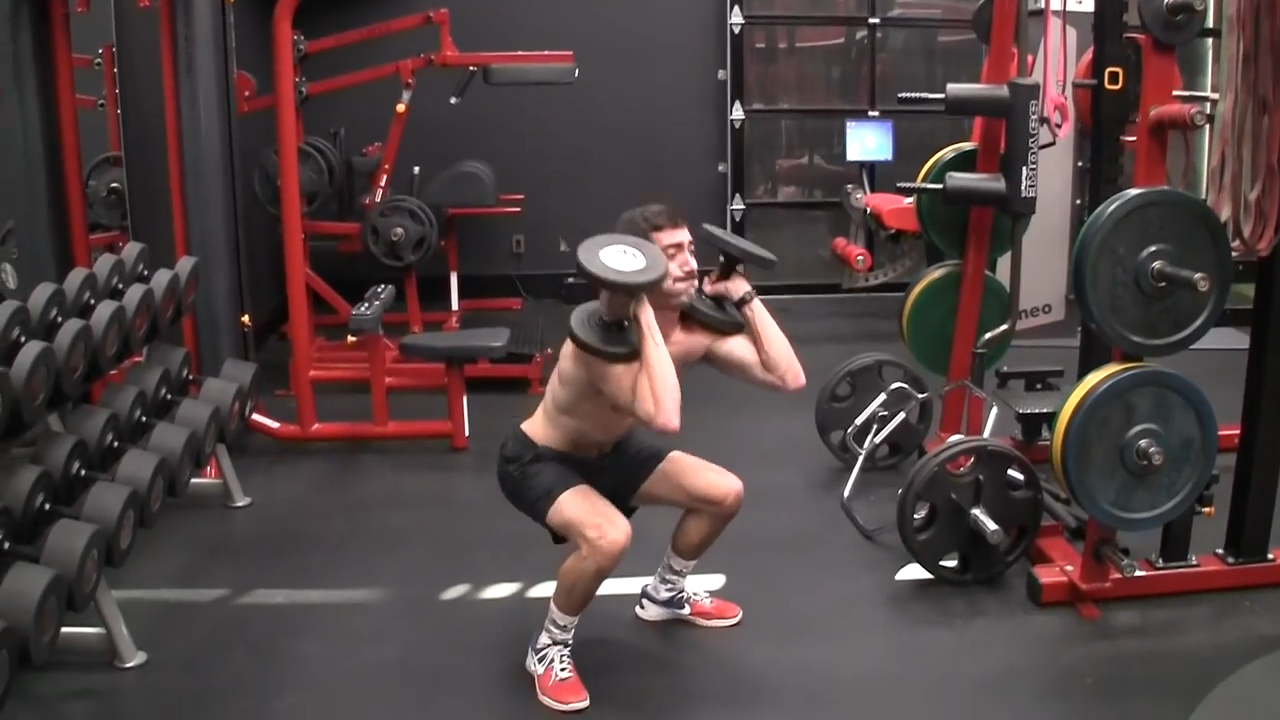
HOW TO DO DUMBBELL SQUAT CLEANS:
- In terms of weight load, begin with two lighter weight dumbbells placed on the floor in front of you. Your feet should be shoulder-width apart, with your toes slightly pointed out.
- Bend your knees and hinge at your hips, keeping your chest up and back straight. Your hands should be gripping the dumbbells, palms facing each other.
- Drive through your heels to explosively lift the dumbbells off the floor. As you extend your hips, knees, and ankles, generate enough momentum to pull the dumbbells upward.
- As the dumbbells reach chest height, quickly rotate your elbows underneath the weights to catch them in a front rack position on top of your shoulders.
- The key here is timing—aim to match the “stomp” of your feet hitting the ground with the moment the dumbbells land on your shoulders. This synchronization is crucial for smooth execution.
- After catching the dumbbells, immediately drop into a squat. Keep your chest up, core engaged, and ensure your knees track over your toes.
- Drive through your heels to stand back up, fully extending your hips at the top. If you’re looking to add an extra challenge, press the dumbbells into an overhead position as you rise, turning this into a Dumbbell Squat Clean and Press for an even more intense full-body movement.
- Lower the dumbbells back to the floor and reset your stance before performing the next rep. Keep the movement controlled, focusing on proper form and alignment each time.
WHAT MAKES IT EFFECTIVE: The Dumbbell Squat Clean is a powerful, full-body exercise that builds explosive strength, coordination, and muscular endurance. This move isn’t just about moving weight from point A to point B—it’s about timing, precision, and maximizing the benefits of a compound lift.
WALK THE BOX

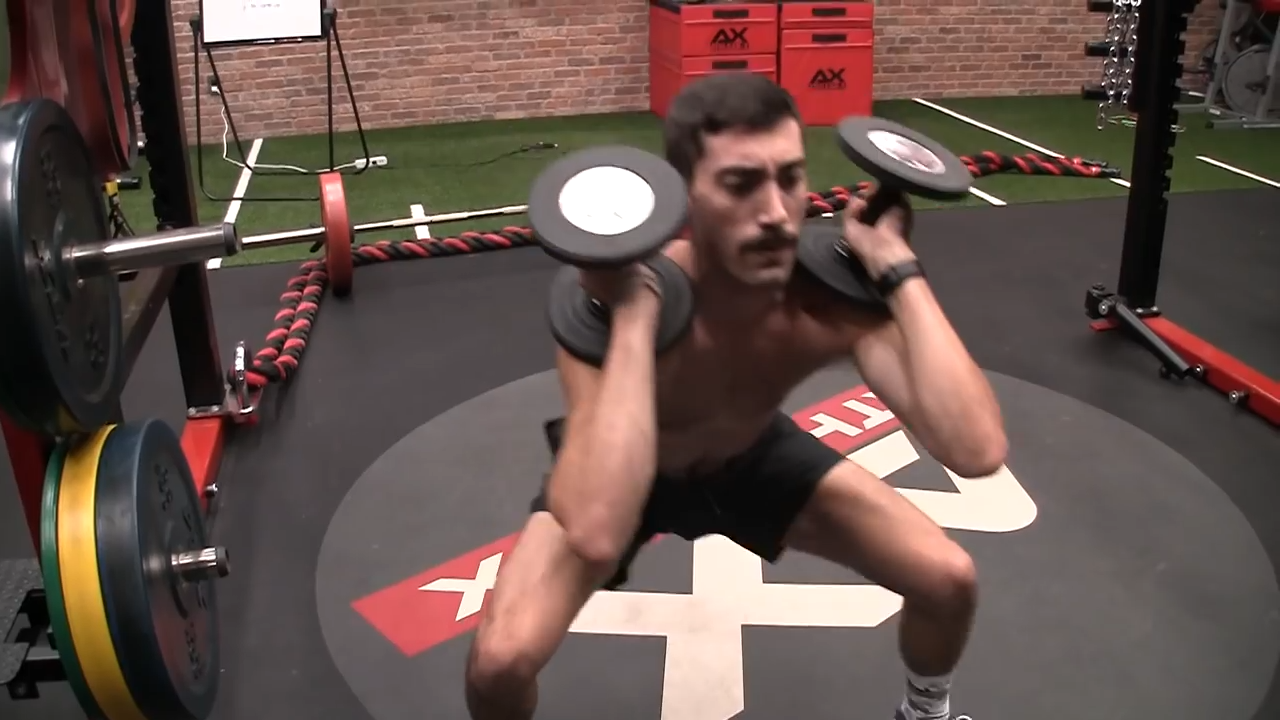
HOW TO DO THE WALK THE BOX EXERCISE:
- In terms of load, grab two light dumbbells and hold them in the front rack position with your elbows up and your upper arms parallel to the floor. Keep your chest up and engage your core—this position challenges incredible grip strength while keeping your torso stable.
- Get into the bottom position of a squat, making sure your feet are shoulder-width apart. Maintain proper hip alignment and focus on avoiding common mistakes like letting your knees cave inward.
- While staying in that low squat position, take small steps to create the shape of a box. Start by stepping your left foot forward, followed by your right foot. Then, move laterally by stepping your left foot sideways, followed by your right foot. Step backward with your left foot, then your right.
- Finish by moving laterally again to return to your starting position.
- Throughout the movement, keep good thoracic extension—don’t let your upper back round.
- Focus on proper movement mechanics to ensure your hips, knees, and ankles are aligned. This will keep the tension in your quads and glutes where it belongs, ensuring maximum overload and metabolic burn.
- The real challenge is maintaining the squat position while completing the box shape. Your legs will be on fire, but that’s exactly what makes this exercise a metabolic powerhouse. Keep your core tight and stay balanced.
WHAT MAKES IT EFFECTIVE: The Walk the Box exercise is a true leg burner and a metabolic challenge that’s perfect for anyone looking for tough but rewarding endurance-focused workouts. This isn’t just about strength—it’s about control, stability, and taking your circuit workout into a new dimension. Whether you’re training at home with a pair of dumbbells or adding variety to your workout routine, this exercise hits multiple muscle groups and enhances your mobility.
SPANISH SQUATS

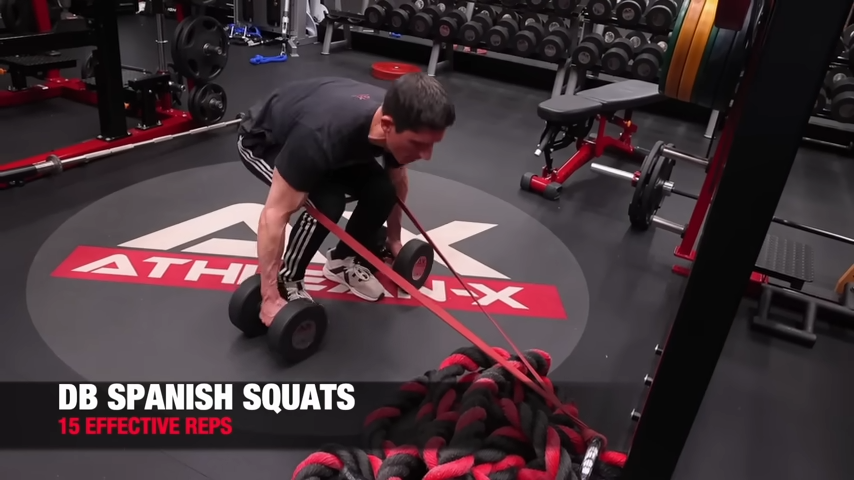
HOW TO DO SPANISH SQUATS:
- This movement incorporates a resistance band, adding a nice challenge to squats. Start by looping a resistance band around a sturdy anchor point, like a squat rack or heavy piece of equipment, and position it behind your knees. You want a band that offers substantial resistance to really engage your quads and resist leg extension.
- Step back until the band is taut and your knees are pulled slightly forward by the tension. The goal is to resist the band’s pull as you squat, which will keep constant tension on your quads, especially during the terminal knee extension phase.
- Hold a pair of dumbbells in your hands at your sides or in the front rack position, depending on your preference. Choose a moderate load that challenges your quads without compromising form—this exercise is more about targeting specific muscles rather than lifting heavy weights.
- With the band anchored behind your knees and the dumbbells held securely, begin your squat. Keep your chest up, core tight, and back straight as you descend. The resistance band will provide an additional challenge by pulling your knees forward, forcing your quads to work even harder.
- As you stand back up, focus on controlling the movement and resisting the band’s pull. The band is actively trying to extend your knees, and your job is to counteract that force, which really lights up the quads and stabilizes the knee joint.
- The key to the Dumbbell Spanish Squat is maintaining time under tension throughout the entire movement. This exercise isn’t about explosive power but rather controlled reps that maximize time under tension, leading to significant quad activation and growth.
WHAT MAKES IT EFFECTIVE: The Dumbbell Spanish Squat is an advanced, specialty squat variation that targets your quads in a unique way by adding both resistance bands and dumbbells into the mix. Traditionally done unloaded with just a resistance band, this variation turns up the intensity by incorporating a pair of dumbbells, making it a powerhouse exercise for quad strength, stability, and hypertrophy. It’s a must for any balanced strength program, especially if you’re doing a HIIT-style workout.
DUMBBELL SQUATS: COMMON MISTAKES
Dumbbell Squats are a staple in any solid strength program, but if you’re not doing them right, you’re leaving gains on the table—and setting yourself up for injury.
Let’s break down the most common mistakes that even seasoned trainers and fitness enthusiasts make with this move.
KNEE COLLAPSE (CAVING INWARD)
One of the biggest form killers in Dumbbell Squats is letting your knees cave inward as you descend.
This not only compromises your knee health but also reduces the effectiveness of the exercise.
Whether you’re chasing hypertrophy versus strength training goals, you need to focus on driving your knees outward and keeping them aligned over your toes.
If you’re struggling with this, work on hip mobility and stability.
Remember, it’s about quality reps, not just getting through the set.
ROUNDING THE LOWER BACK
Losing your spinal alignment is a recipe for disaster, especially when holding weights.
Keep your chest up and core tight to maintain that neutral spine throughout the movement.
Many people think they can just pick up a pair of dumbbells and squat, but if your lower back rounds, you’re risking more than just a bad workout.
This is where personal trainers and education videos focusing on proper form can make all the difference.
HEELS COMING OFF THE GROUND
You’ve probably seen this mistake in countless videos—a lifter’s heels pop up as they squat down, shifting the weight onto their toes.
This happens when you lack ankle mobility or are simply not engaging your posterior chain correctly.
Your entire foot needs to stay planted—heels included—to generate full-body strength and stability.
Fixing this might require some mobility work, but it’s important for better performance and injury prevention.
LEANING TOO FAR FORWARD
While it’s tempting to lean forward to get deeper, this shifts the load away from your legs and onto your lower back.
Keep your chest up and shoulders back, with the dumbbells held in the right position for your chosen variation of these challenging movements.
Whether you’re following a personal trainer’s cue or working through a comprehensive exercise library, proper posture is non-negotiable.
USING TOO MUCH WEIGHT TOO SOON
We get it—everyone wants to push heavy weights. But if your form breaks down because you’re going too heavy, you’re doing more harm than good.
Dumbbell Squats are all about controlled strength and tension, not just lifting the heaviest dumbbells in the gym.
Start with a moderate load and focus on mastering the movement before loading up. This approach leads to better long-term progress, whether you’re doing hypertrophy versus strength training.
Mastering the Dumbbell Squat is all about focusing on proper form, consistent practice, and gradual progression.
Focus on keeping your core tight, maintaining knee alignment, and controlling your movement, you’ll build strength, stability, and muscle growth.
Incorporate this versatile exercise into your routine, and you’ll see real gains that carry over into all areas of your training.
If you’re looking for a training program that covers every muscle in the body, we’ve got you covered. Check out our ATHLEAN-X programs to see which is the best fit for your goals and fitness level.

- Dumbbell Squats are an excellent alternative to the traditional Barbell Squat. Not only do they allow for more freedom of movement, but they also take away the risks that are inherent with the technically complicated Barbell Squat.
- Here’s how to do Dumbbell Squats:
- Hold a pair of dumbbells either at your sides or at shoulder level, depending on the variation you prefer.
- Position your feet shoulder-width apart with your toes slightly angled out for better balance and alignment.
- Plant your heels firmly on the ground and keep your entire foot stable—no lifting your heels or shifting your weight onto your toes.
- Tighten your core and keep your chest up with your shoulders back. This posture ensures your spine stays neutral and your upper body remains stable.
- Initiate the squat by driving your hips backward, followed by bending your knees. Ensure your knees follow the path of your toes and don’t collapse inward—this is a common mistake.
- Lower your body until your thighs are parallel to the ground or even deeper if your flexibility allows, while maintaining proper knee alignment.
- Drive through your heels and midfoot to rise back to the starting position, focusing on engaging your glutes and quads to power the movement.
- Maintain a tight core throughout, which helps stabilize your torso and protect your lower back as you complete each rep.
DUMBBELL SQUATS FAQS
Absolutely. Dumbbell Squats are not just effective; they’re essential for building strength, balance, and mobility. Here’s why:
Versatility: Whether you’re doing a quick workout between watching meal prep videos or focusing on hypertrophy in the gym, Dumbbell Squats adapt to your goals. Adjust stance, load, and depth to match your needs.
Balanced Strength: Unlike Barbell Squats, dumbbells force each side to work equally, correcting imbalances and reducing injury risk.
Core Engagement: Holding dumbbells challenges your core more effectively, leading to better stability and functional strength.
Mobility and Flexibility: Dumbbell Squats let you train hard while accommodating mobility issues, offering more freedom in movement and depth.
Trainer-Approved: A staple in comprehensive exercise libraries, Dumbbell Squats are highly effective and accessible for all fitness levels.
Whether you’re working through a bodyweight workout or looking to build serious strength, Dumbbell Squats deliver results with minimal equipment. Simple, effective, and versatile—no excuses, just gains.
Dumbbell Squats might seem straightforward, but if you're not nailing the fundamentals, you're compromising both your gains and safety.
Start by standing with your feet shoulder-width apart and holding a pair of dumbbells either at your sides or in a racked position at shoulder height. Keep your chest up, core braced, and back straight.
Initiate the squat by driving your hips backward, followed by bending your knees to descend into the squat. Keep your knees aligned with your toes—don’t let them collapse inward.
Lower until your thighs are at least parallel to the ground or deeper if your mobility allows. Control the descent to fully engage your muscles.
As you rise, drive through your heels and midfoot, extending your hips fully at the top while keeping the dumbbells stable and your core tight.
Both the Dumbbell Squat and Goblet Squat are effective exercises, but there’s a key difference in how they’re performed and what they target.
In a Dumbbell Squat, you’re holding a pair of dumbbells at your sides. This position forces you to engage your core and stabilizers more, and it also distributes the load evenly across both sides of your body. It’s great for building balanced strength and targeting the quads, glutes, and hamstrings.
In a Goblet Squat, you’re holding a single dumbbell or kettlebell close to your chest in a goblet position. This variation is ideal for beginners because it naturally encourages better squat form—keeping your chest up and helping you stay upright. The Goblet Squat is also perfect for targeting the quads while adding more emphasis on core engagement due to the weight being held in front.
The bottom line? The Dumbbell Squat is a great choice for balanced, full-body strength, while the Goblet Squat is your go-to for learning proper squat mechanics and emphasizing quad development. Both are valuable tools in your exercise arsenal depending on your goals and training experience.
Short answer? Yes. But here’s what you need to know.
Dumbbell Squats are a powerful fat-burning exercise, but not because they magically melt fat away. The key lies in the muscle engagement and intensity they bring.
When you perform Dumbbell Squats, you’re targeting multiple muscle groups—quads, glutes, hamstrings, and core—all in one movement. The more muscle you activate, the more calories you burn during and after your workout.
Dumbbell Squats also crank up your heart rate, making them an effective way to hit both strength and cardio at the same time.
Combine that with a well-structured diet and smart meal prep, and you’ve got a recipe for serious fat loss.
Remember, fat burning isn’t just about the exercise itself—it’s about creating a consistent routine that balances strength training, cardio, and nutrition.
REFERENCES

Jeff Cavaliere M.S.P.T, CSCS
Jeff Cavaliere is a Physical Therapist, Strength Coach and creator of the ATHLEAN-X Training Programs and ATHLEAN-Rx Supplements. He has a Masters in Physical Therapy (MSPT) and has worked as Head Physical Therapist for the New York Mets, as well as training many elite professional athletes in Major League Baseball, NFL, MMA and professional wrestling. His programs produce “next level” achievements in muscle size, strength and performance for professional athletes and anyone looking to build a muscular athletic physique.


















